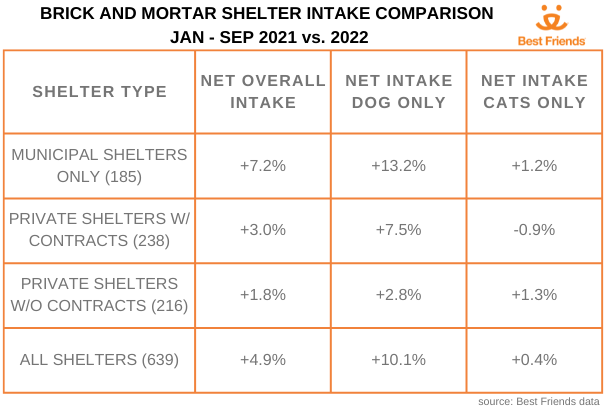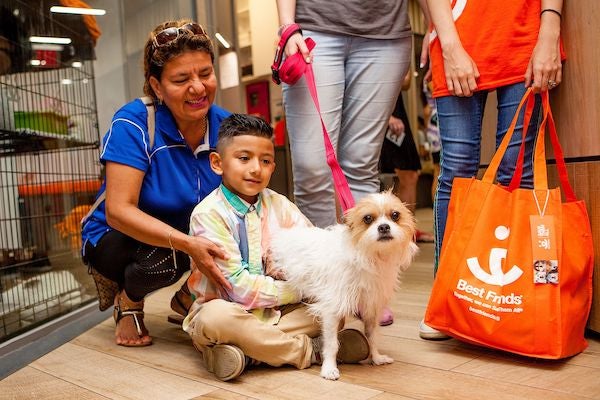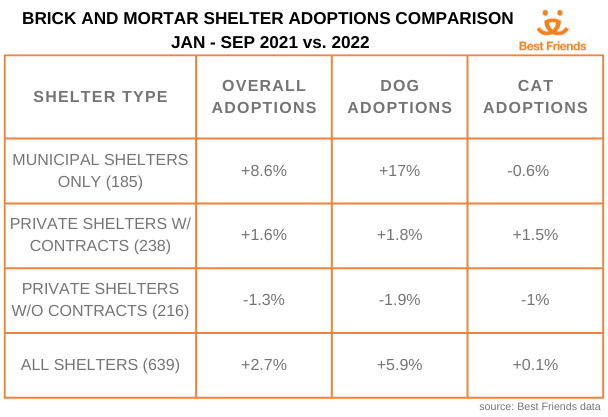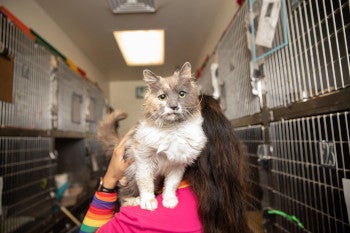
The reality of today's shelter struggles
Data reveals adoption disparities between municipal and private shelters
2022 has been a tough year for shelters. We came out of the pandemic with high inflation, staffing shortages and rising shelter intakes. It’s been heartbreaking talking to many of our shelter partners, some of whom have been no-kill for years, who are starting to make space-based euthanasia decisions.
 We have been looking at national data trends for months and seeing the challenges that shelters are facing. While shelter intake is up 4.9% in 2022 (10.1% for dogs!), positive outcomes are not keeping pace, as live outcomes are down -2.1% (-0.4% for dogs). This reduction in outcomes has not only caused an increase in shelter deaths, but it has also led to what "Shelter Animals Count is referring to as a “population imbalance,” with more animals in shelters and increased strain on shelter staff.
We have been looking at national data trends for months and seeing the challenges that shelters are facing. While shelter intake is up 4.9% in 2022 (10.1% for dogs!), positive outcomes are not keeping pace, as live outcomes are down -2.1% (-0.4% for dogs). This reduction in outcomes has not only caused an increase in shelter deaths, but it has also led to what "Shelter Animals Count is referring to as a “population imbalance,” with more animals in shelters and increased strain on shelter staff.
Best Friends responded to this need for increased adoptions by sponsoring three major adoption events for network partners this summer. They were wildly successful – more than 25,000 dogs and cats found homes during the three weekend events. Because of this success, we are sponsoring a fourth event in December to help even more animals end the year in new homes.
The big picture on intakes
While daily struggles continue for shelters across the country the data doesn’t match what many of our partners are experiencing. So, we felt the need to dig deeper and as it turns out, not everyone is experiencing challenges in the same way.
We broke down the data by the different types of brick-and-mortar shelters: municipals, private organizations with municipal contracts and purely private organizations without a contract. And the differences are surprising.
The following highlights are based on data collected from 639 brick-and-mortar shelters (185 municipals, 238 privates with contracts and 216 without contracts, representing 1.3 million total intakes for the nine months). We compared January to September 2022 data to the same time period in 2021.
What we found is that municipal shelters are seeing 7.2% more cats and dogs come in this year, while private organizations have a much smaller overall increase of 1.8% for dogs and cats combined. Private organizations with contracts are splitting the difference with an overall 3% increase in intake. And every organization type is seeing a higher number of dogs come in this year as compared to 2021. Municipal shelters are once again seeing more dramatic increases with 13.2% more dogs are coming through the doors compared to 2.8% at private shelters.

Adding up adoptions
The intake numbers aren't necessarily surprising, as private organizations usually have a lot more control over their intake than municipal agencies. But the disparity gets even more pronounced with adoptions.

Across all organizations, adoptions are up 2.7% overall and 5.9% for dogs. However, municipal shelters are out-performing private groups, with adoptions up 8.6% in total and an astonishing 17% for dogs! So why are they still struggling? Unfortunately, the gains have been largely canceled out by the decrease in transfers – municipal transfers are down 18% overall and 16.9% for dogs.
Meanwhile, private organizations are seeing a 1.3% decrease in total adoptions and a 1.9% decrease in adoptions for dogs. Again, private organizations with contracts have split the difference a bit and are up 1.6% in total adoptions, and 1.8% for dogs.

So, while municipal agencies have increased adoptions by 17% for dogs in 2022, private organizations have actually decreased adoptions for dogs by 1.9%. While we’ve been having a national conversation about the need to increase adoptions, not all organizations are experiencing such a trend – and the decrease in adoptions is being largely driven by private organizations (many of which are very well funded).  This in turn has really slowed transports, which are such an important live outcome option for many municipal agencies – as well as many private organizations.
This in turn has really slowed transports, which are such an important live outcome option for many municipal agencies – as well as many private organizations.
This has come at a devastating price to municipal agencies, which have seen a 103% increase in dogs killed (defined by the number of dogs euthanized beyond the 90% no-kill benchmark) year over year. That’s a high price indeed for both the animals whose lives are lost and for the staff making those decisions.
And I’ll close by noting that not all private organizations have been slower to ramp up adoptions. Maybe not even most. If your private organization is increasing its adoptions and intakes to keep up with the national volume of animals – thank you. Thank you for continuing to adjust rapidly as we come out of this pandemic. But if your shelter is among those who are still working well below 2019 capacities, the industry needs you right now.
The goal of decreasing shelter deaths to get to no-kill by 2025 is going to take all of us working together for the betterment of shelter pets across the nation. But we need to all feel the struggle and not put it on the backs of a smaller subset of shelter workers.

Brent Toellner
Senior director of lifesaving programs
Best Friends Network
If you enjoyed this editorial, you can find our complete catalog of editorials here.